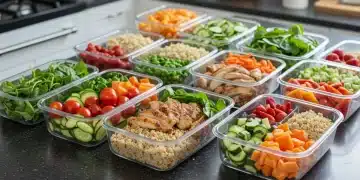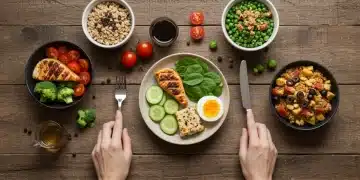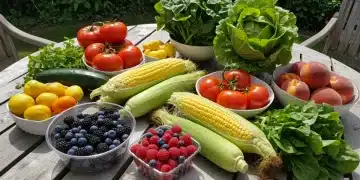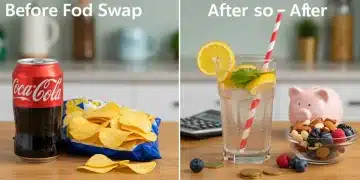Budget-Friendly Nutrition: Healthy Eating on Under $50/Week in 2025
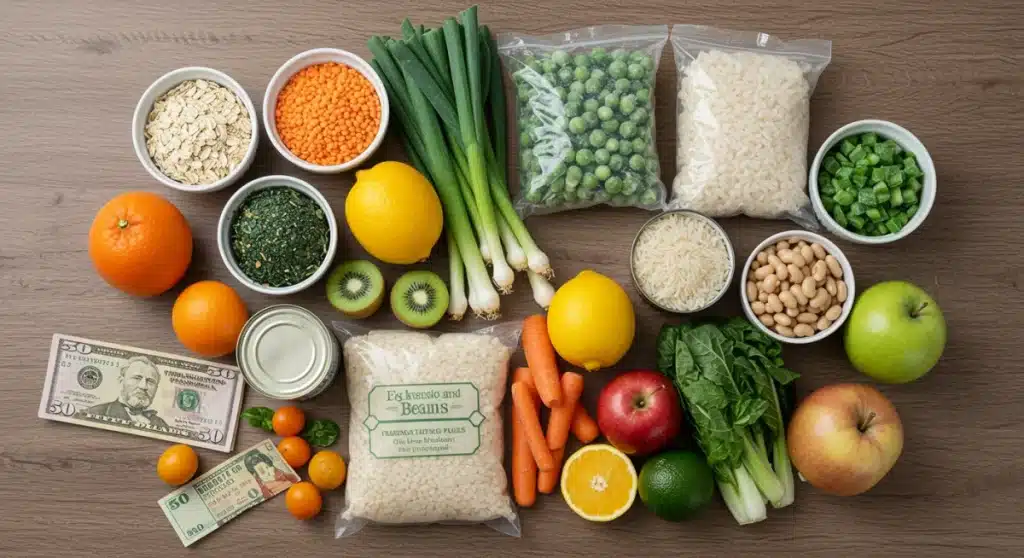
Achieving optimal health through budget-friendly nutrition is entirely possible in 2025, by employing strategic meal planning, smart grocery shopping, and utilizing cost-effective ingredients to eat healthy on under $50 a week.
Navigating the grocery aisles with a tight budget can often feel like a daunting task, especially when striving for nutritious choices. However, achieving budget-friendly nutrition and eating healthy on under $50 a week in 2025 is not only possible but also a highly rewarding endeavor that can significantly impact your financial well-being and health.
Understanding the $50 Weekly Food Budget Challenge
Living on a strict food budget, particularly one as modest as $50 a week, demands a strategic approach to grocery shopping and meal preparation. This isn’t just about cutting costs; it’s about making informed decisions that prioritize both your nutritional needs and your financial health. The challenge lies in maximizing nutrient density while minimizing expenditure, requiring a shift in perspective from convenience to conscious consumption.
Many assume that healthy eating is inherently expensive, a misconception often fueled by the marketing of specialty health foods. However, the foundational elements of a truly healthy diet—whole grains, legumes, seasonal produce, and lean proteins—are often the most affordable options available. The key is to reframe your shopping habits and embrace culinary creativity to transform these basic ingredients into satisfying, wholesome meals.
The average American household faces rising food costs, making the $50 weekly budget even more relevant in 2025. This financial constraint can, paradoxically, lead to healthier eating habits by encouraging home cooking, reducing reliance on expensive processed foods, and fostering an appreciation for simple, nourishing ingredients. It’s a journey of discovery, proving that good health doesn’t have to break the bank.
Strategic Meal Planning: The Cornerstone of Savings
Effective meal planning is arguably the most critical component of adhering to a $50 weekly food budget. Without a clear plan, impulse purchases and food waste can quickly derail your efforts. A well-thought-out meal plan ensures every dollar is spent purposefully, contributing to diverse and nutritious meals throughout the week.
Begin by assessing your current pantry and refrigerator contents to avoid buying duplicates. Then, consider meals that utilize versatile ingredients. For instance, a bag of lentils can become a hearty soup, a filling salad topping, or a base for vegetarian burgers. This multi-purpose approach reduces the number of different ingredients you need to buy, leading to significant savings.
Creating Your Weekly Meal Plan
When devising your meal plan, focus on a balance of macronutrients and micronutrients. Don’t just think about what you’ll eat, but how you’ll prepare it to maximize flavor and nutritional value without expensive additions.
- Theme Nights: Assign themes like “Meatless Monday” or “Taco Tuesday” to simplify planning and reduce decision fatigue.
- Ingredient Repurposing: Plan for leftovers or ingredients that can be transformed into new meals. Cook a large batch of rice to use in multiple dishes.
- Seasonal Focus: Prioritize produce that is in season, as it’s typically cheaper and fresher.
Once your plan is set, create a detailed shopping list. Stick to this list rigorously at the grocery store. This discipline prevents impulse buys and keeps your budget in check. Remember, every item added to your cart without a plan is a potential drain on your precious $50.
Smart Grocery Shopping: Maximizing Every Dollar
Stepping into the grocery store with a $50 limit requires a sharp eye and a strategic mindset. This isn’t just about finding the cheapest options; it’s about identifying the best value for your money, balancing cost with nutritional content and versatility. Smart grocery shopping is crucial for achieving budget-friendly nutrition.
Start by shopping at stores known for their affordability, such as discount supermarkets or farmers’ markets. While farmers’ markets might seem expensive, seasonal produce can often be found at competitive prices, especially towards the end of the day when vendors are eager to sell remaining stock. Always compare unit prices to determine the true cost-effectiveness of an item, rather than just looking at the sticker price.

Key Shopping Strategies for Under $50
To keep your spending under $50, adopt these habits:
- Shop Sales and Use Coupons: Always check weekly flyers and digital coupons. Plan meals around items that are on sale.
- Buy in Bulk (Wisely): Non-perishable staples like rice, pasta, oats, and dried beans are often cheaper when bought in larger quantities. Ensure you have storage space and will actually use the bulk items before they spoil.
- Prioritize Store Brands: Generic or store-brand products are usually significantly cheaper than name brands and often offer comparable quality.
- Frozen and Canned Goods: Don’t overlook frozen fruits and vegetables, which are often just as nutritious as fresh, and sometimes more affordable, especially out of season. Canned beans and tomatoes are also excellent, cost-effective pantry staples.
Avoid shopping when hungry, as this can lead to impulsive and unnecessary purchases. A full stomach helps maintain discipline. Furthermore, consider making a list of your top 10-15 most frequently purchased items and track their prices across different stores to identify the best deals consistently.
Embracing Pantry Staples: Affordable and Nutritious Foundations
A well-stocked pantry of affordable staples forms the backbone of any successful budget-friendly nutrition plan. These foundational ingredients are not only inexpensive but also incredibly versatile, allowing you to create a wide array of meals without constantly buying new items. Focusing on these staples helps stretch your $50 budget further than you might imagine.
Legumes, such as lentils, chickpeas, and black beans, are powerhouses of protein and fiber, making them excellent meat alternatives. Grains like brown rice, oats, and whole wheat pasta provide complex carbohydrates for sustained energy. These items are typically very cheap when bought dried or in larger quantities, offering substantial savings over pre-cooked or processed versions.
Essential Pantry Items for Under $50
Here are some must-have staples that are both affordable and provide significant nutritional value:
- Dried Beans and Lentils: Inexpensive, high in protein and fiber, perfect for soups, stews, and salads.
- Brown Rice and Oats: Whole grains that offer sustained energy and can be used in numerous sweet and savory dishes.
- Canned Tomatoes: A versatile base for sauces, soups, and stews. Look for low-sodium options.
- Frozen Vegetables: Often cheaper than fresh counterparts, especially out of season, and retain their nutritional value.
- Eggs: An affordable source of high-quality protein, versatile for breakfasts, lunches, and dinners.
- Root Vegetables: Potatoes, carrots, and onions are inexpensive, store well, and form the base of many hearty meals.
By building your meals around these staples, you reduce the need for more expensive, perishable items. This approach not only saves money but also minimizes food waste, as these ingredients have a long shelf life. Learning to cook with these basics can open up a world of culinary possibilities, proving that nutritious eating doesn’t require exotic ingredients.
Creative Cooking and Meal Prepping Strategies
Once you have your affordable ingredients, the next step in achieving budget-friendly nutrition is to employ smart cooking and meal prepping strategies. These methods ensure that your groceries are used efficiently, food waste is minimized, and healthy meals are readily available, preventing costly last-minute food decisions.
Cooking at home is almost always cheaper and healthier than eating out or buying pre-made meals. Dedicate a specific time each week, perhaps a Sunday afternoon, to chop vegetables, cook grains, and prepare large batches of protein. This foresight saves time during busy weekdays and ensures you always have wholesome options at hand, reducing the temptation to order takeout.
Making the Most of Your Ingredients
Maximizing the use of every ingredient is key to staying within your $50 budget. Think about how to use vegetable scraps for broth, or how to transform leftover roasted chicken into a salad or sandwich filling for the next day. This minimizes waste and extends the value of your purchases.
- Batch Cooking: Prepare larger quantities of staple foods like rice, quinoa, roasted vegetables, and cooked proteins.
- Freezing Portions: Divide cooked meals into individual portions and freeze them. This is a lifesaver for busy days and prevents food spoilage.
- One-Pot Meals: Utilize recipes that can be cooked in a single pot or pan to save on cleanup time and simplify the cooking process.
- Repurpose Leftovers: Don’t just reheat; transform. Leftover chili can become a topping for baked potatoes, or extra rice can be turned into fried rice.
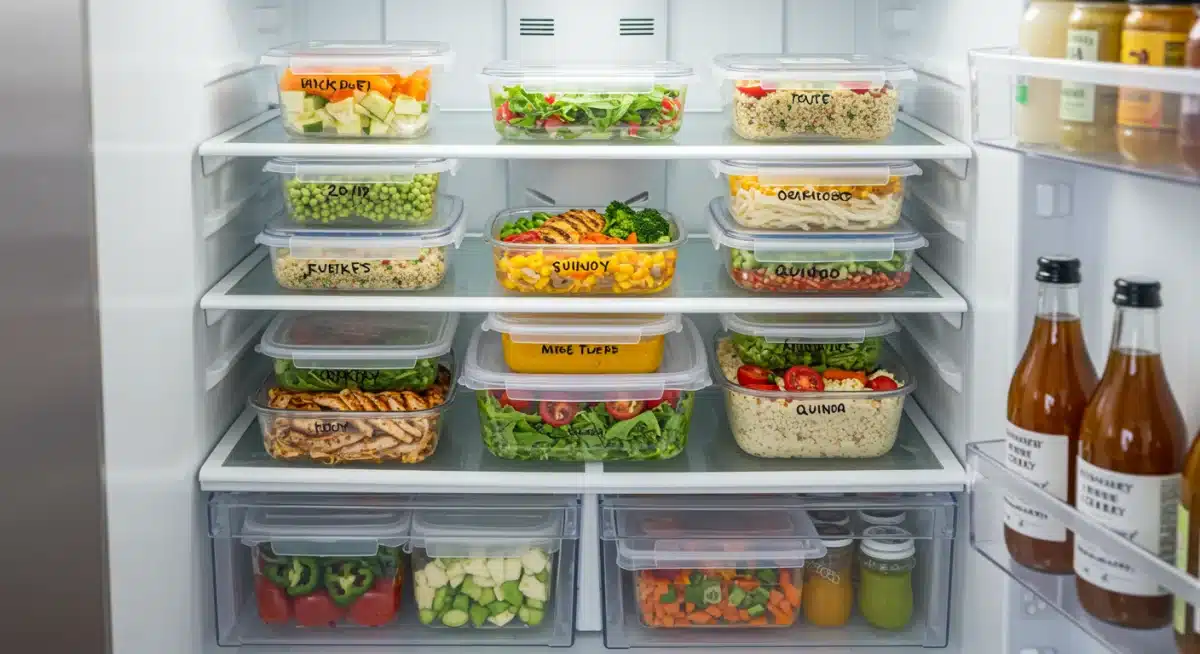
These strategies not only help you stay within your budget but also cultivate a more mindful approach to food. You’ll become more aware of what you’re eating, how it’s prepared, and the value it provides, both nutritionally and financially.
Beyond the Kitchen: Lifestyle Habits for Financial Impact
While smart shopping and cooking are central to budget-friendly nutrition, certain lifestyle habits can further enhance your ability to eat healthy on under $50 a week and positively impact your overall financial situation. These habits extend beyond the kitchen, influencing how you perceive and manage your resources.
One significant habit is reducing food waste. Globally, a substantial amount of food is wasted, and for budget-conscious individuals, this is money literally thrown away. Learn proper food storage techniques, understand “best by” dates versus “use by” dates, and get creative with ingredients that are nearing their end. Composting food scraps can also be a sustainable practice, although not directly financial, it reflects a mindful approach to resources.
Cultivating Sustainable and Frugal Habits
Adopting a minimalist approach to consumption can also free up funds for quality food. Evaluate your spending in other areas of your life to see where you might be able to reallocate funds towards your food budget, if necessary, or simply to improve your overall financial health.
- Grow Your Own: Even a small herb garden on a windowsill can save money on fresh herbs and add flavor to your meals.
- Drink Water: Prioritize water over expensive sugary drinks or juices. It’s free from the tap and essential for health.
- Avoid Processed Snacks: These are often expensive and offer little nutritional value. Opt for fruits, nuts, or homemade popcorn instead.
- Share and Swap: If you have an abundance of a certain ingredient, consider sharing with friends or family, or swapping for something you need.
These habits foster a more holistic approach to personal finance and health. By being intentional about your choices, both in and out of the kitchen, you create a virtuous cycle where healthy eating supports financial stability, and financial stability supports healthy living. It’s about building a sustainable framework for your well-being in 2025 and beyond.
| Key Strategy | Brief Description |
|---|---|
| Strategic Meal Planning | Plan meals around versatile, affordable ingredients to minimize waste and impulse buys, ensuring a balanced diet. |
| Smart Grocery Shopping | Focus on sales, store brands, seasonal produce, and bulk buying for staples to maximize your $50 budget. |
| Embracing Pantry Staples | Build meals around inexpensive, versatile items like legumes, whole grains, and frozen vegetables for cost-effective nutrition. |
| Creative Cooking & Prep | Batch cook, freeze portions, and repurpose leftovers to prevent food waste and ensure healthy meals are always at hand. |
Frequently Asked Questions About Budget-Friendly Nutrition
Yes, it is entirely possible with careful planning and smart choices. This budget requires focusing on whole, unprocessed foods like grains, legumes, seasonal vegetables, and affordable protein sources, alongside strategic meal preparation to minimize waste.
Excellent budget-friendly protein sources include dried or canned beans and lentils, eggs, tofu, and chicken thighs or drumsticks when on sale. These provide essential nutrients without the high cost of premium cuts of meat or processed protein supplements.
To reduce food waste, plan your meals meticulously, utilize leftovers creatively, store food properly to extend its shelf life, and understand expiration dates. Freezing excess portions of cooked meals or fresh produce before it spoils is also highly effective.
Often, yes. Frozen fruits and vegetables are typically picked at their peak ripeness and flash-frozen, preserving their nutritional content. They are also usually more affordable, especially out of season, making them excellent choices for budget-friendly nutrition.
Essential skills include basic knife work for chopping vegetables, understanding how to cook grains and legumes from scratch, and being able to create simple sauces or dressings. Batch cooking and repurposing ingredients are also critical for maximizing your budget and minimizing effort.
Conclusion
Achieving budget-friendly nutrition and eating healthy on under $50 a week in 2025 is not merely a financial restriction but an opportunity to cultivate healthier, more mindful habits. By embracing strategic meal planning, smart grocery shopping, prioritizing affordable pantry staples, and leveraging creative cooking techniques, individuals can nourish their bodies effectively without compromising their financial stability. This approach proves that good health is accessible to everyone, regardless of budget constraints, fostering a sustainable path toward well-being.
